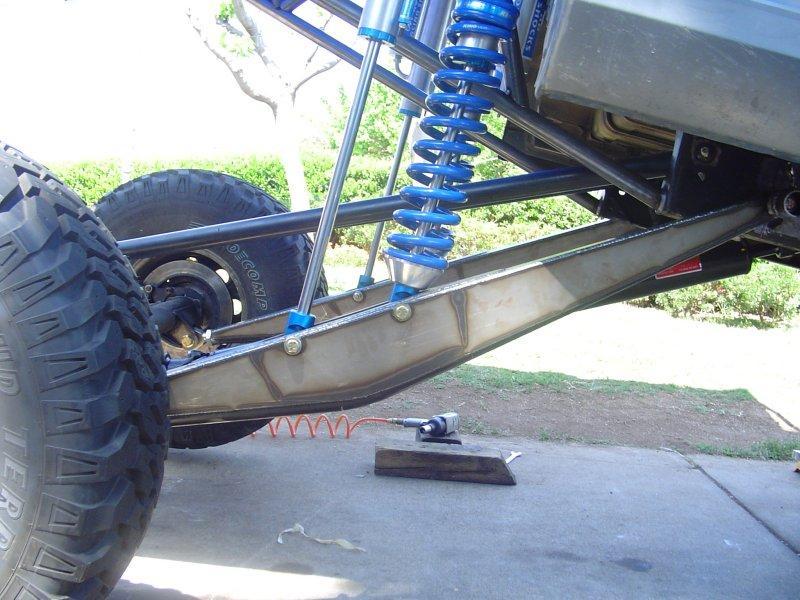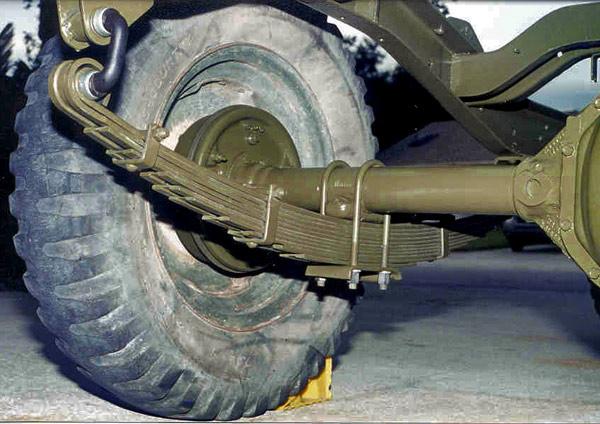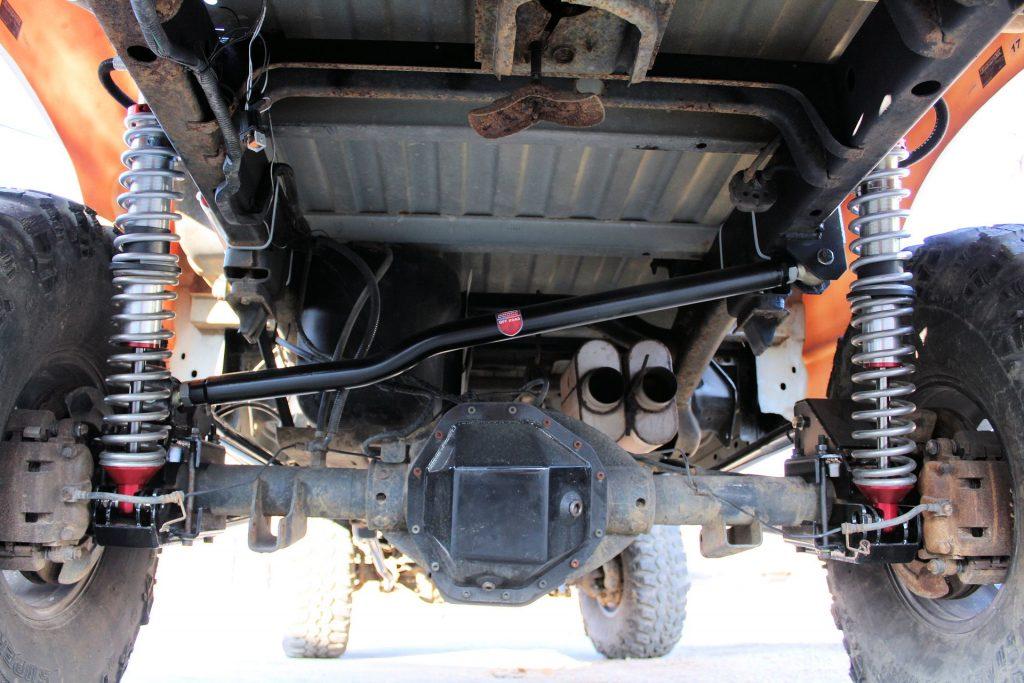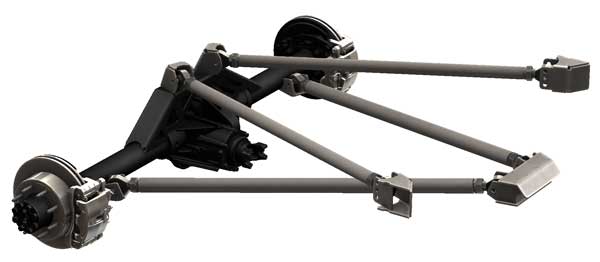Does a 4-Link Replace Leaf Springs?
By Sebastian Orellana
Updated Feb 18, 2024

Leaf springs have been the go-to suspension system for off-road vehicles for generations, but technological advancements in the automotive industry have generated an alternative to the traditional leaf spring setup: the four-link suspension. This article will explore the advantages and disadvantages of the 4-link suspension, as well as how it compares with leaf springs.
Table of Contents
We will discuss the benefits of the 4-link system in terms of performance, handling, and cost. Additionally, we will review the various configurations of 4-link suspension and how they compare with leaf springs.
READ: Best Supercharger Brands: An In-Depth Look
Leaf Spring Suspension

Leaf springs are a traditional suspension system that consists of a few layers of metal plates, called leaves, which are connected together by bolts or rivets. The leaves are curved in an arc, which is why they are referred to as “leaf” springs. The leaf springs are attached to the frame of the vehicle at one end, and the axle at the other. The curved shape of the springs allows them to absorb road bumps, providing a smooth ride for the occupants.
The leaf spring suspension system is relatively simple to install and maintain, and the components are relatively inexpensive. Additionally, the leaf spring setup offers a good amount of flex, which helps to reduce road vibrations. The downside of the leaf spring setup is that it is not as effective at keeping the wheels planted on uneven terrain, which can lead to poor handling.
4-Link Suspension

The 4-link suspension system is an alternative to the leaf spring suspension that utilizes four control arms, or links, to keep the wheels attached to the frame. The links are connected to the frame at one end, and the axle at the other. By utilizing the four links, the 4-link system is able to provide a more consistent handling experience than the leaf spring setup.
The 4-link suspension system is relatively easy to install and maintain, and the components are relatively inexpensive. Additionally, the 4-link system offers improved ride quality on rough terrain and cornering ability. The downside of the 4-link system is that it can be more difficult to tune than the leaf spring setup.
Advantages of the 4-Link Suspension
The 4-link suspension system offers numerous advantages over the leaf spring setup. The 4-link system offers improved handling over uneven terrain, as well as improved cornering ability. Additionally, the 4-link system is more adjustable, allowing for more precise tuning of the suspension. The 4-link setup is more effective at keeping the wheels planted, which can lead to improved traction in off-road conditions.
The 4-link system also offers improved ride quality, as the four links can better absorb road bumps and vibrations. Additionally, the 4-link system is relatively simple to install and maintain, and the components are relatively inexpensive. The 4-link system also offers improved performance, as the four links are better able to keep the wheels planted, resulting in improved acceleration and braking.
Disadvantages of the 4-Link Suspension
The 4-link suspension system also has some drawbacks. The 4-link system can be more difficult to tune than the leaf spring setup, as the four links must be adjusted in unison to achieve the desired ride quality. Additionally, the 4-link system can be more complex to install, as it requires more components than a leaf spring setup.
The 4-link system also requires more maintenance than a leaf spring setup, as the four links must be inspected and adjusted on a regular basis to ensure optimal performance. Additionally, the 4-link system can be more expensive to install than a leaf spring setup, as it requires more components.
Comparing 4-Link and Leaf Spring Suspension

When comparing the 4-link and leaf spring suspension systems, it is important to consider both the advantages and disadvantages of each system. The leaf spring system offers a relatively simple installation, as well as a good amount of flex, which helps to reduce road vibrations. The leaf spring setup is also relatively easy to maintain, and the components are relatively inexpensive.
The 4-link system offers improved performance, as the four links are better able to keep the wheels planted, resulting in improved acceleration and braking. Additionally, the 4-link system offers improved handling over uneven terrain, as well as improved cornering ability. The 4-link system is also more adjustable, allowing for more precise tuning of the suspension.
However, the 4-link system can be more difficult to install and more expensive to purchase, as it requires more components. Additionally, the 4-link system can be more difficult to tune than the leaf spring setup, as the four links must be adjusted in unison to achieve the desired ride quality. The 4-link system also requires more maintenance than a leaf spring setup, as the four links must be inspected and adjusted on a regular basis to ensure optimal performance.
READ: How Much Is A Mustang Boss 429?
Different Types of 4-Link Suspension

There are several different types of 4-link suspension systems, each offering different advantages and disadvantages. The most common type of 4-link suspension is the single triangulated 4-link system. This type of 4-link system utilizes two upper links and two lower links, with the upper links connected to the frame and the lower links connected to the axle. This type of 4-link system offers improved handling and cornering ability, as well as improved traction.
The double-triangulated 4-link system utilizes two upper and two lower links connected to the frame and the axle. This type of 4-link system offers improved handling and cornering ability, as well as increased adjustability. Additionally, this type of 4-link system can be used to improve the acceleration and braking of the vehicle.
The trailing arm 4-link system utilizes two trailing arms, which are connected to the axle and the frame. This type of 4-link system offers improved handling and cornering ability, as well as improved traction. Additionally, this type of 4-link system can be used to improve the acceleration and braking of the vehicle.
Cost of 4-Link Suspension
The cost of a 4-link suspension system will depend on the type of system you choose and the components you need. Single-triangulated 4-link systems typically range from $500 to $1,000, while double-triangulated 4-link systems typically range from $1,000 to $2,000.
Trailing arm 4-link systems typically range from $1,500 to $3,000. Additionally, you will need to factor in the cost of installation, which can range from $500 to $2,000, depending on the complexity of the system.
Installation of 4-Link Suspension
The installation of a 4-link suspension system is relatively straightforward, but it is important to make sure that the components are properly installed and adjusted. To properly install the 4-link system, you will need to attach the four links to the frame and axle, as well as adjust the length of the links to ensure that the wheels are properly aligned. Additionally, you will need to adjust the tension on the links to ensure that the suspension is properly tuned.
Maintenance of 4-Link Suspension
The maintenance of a 4-link suspension system is relatively simple, but it is important to inspect and adjust the components on a regular basis. To properly maintain the 4-link system, you will need to inspect the four links for any signs of wear or damage and adjust the tension on the links to ensure that the suspension is properly tuned.
Additionally, you will need to check the alignment of the wheels and adjust the length of the links to ensure that the wheels are properly aligned.
READ: What Does A Sway Bar Do?
Conclusion
In conclusion, the 4-link suspension system offers numerous advantages over the traditional leaf spring setup, including improved performance, improved handling, and improved ride quality. Additionally, the 4-link system is relatively simple to install and maintain, and the components are relatively inexpensive.
However, the 4-link system can be more difficult to tune than the leaf spring setup, as the four links must be adjusted in unison to achieve the desired ride quality.
